“You’ve Got…” on AOL
Skeptic magazine editor Michael Shermer discusses why people are often duped…


Skeptic magazine editor Michael Shermer discusses why people are often duped…
TO ALL TEACHERS AND PROFESSORS who are teaching courses in skepticism, critical thinking, science and pseudoscience, science and the paranormal, science studies, history or philosophy of science, the psychology of paranormal beliefs, religious studies, and the like…
Please send us your course syllabuses, reading lists, video/YouTube links, classroom demonstration ideas, student projects and experiments, research project ideas, and the like to my graduate student Anondah Saide. I want to add them to my own course syllabus on Skepticism 101, and create an online Skeptical Studies Program at Skeptic.com for teachers and professors everywhere to go to in a creative commons/open source system so that we can build a new academic field going forward with skepticism into academia.
I know that such courses are being taught around the world because for the past two decades of publishing Skeptic magazine and writing skeptical books, I receive a lot of mail from teachers and professors seeking permission to use our materials.
What I would like to do is to create academic departments of Skeptical Studies, as the next step in the skeptical movement. (See, for example, Phil Zuckerman’s program of Secular Studies he is implementing this year at Pitzer College in Claremont, where I teach a graduate course in the spring. We have magazines and journals, trade books and conferences. The next step is a more organized penetration into academia via courses, textbooks, departments, and the like. I want to create a clearing house, an open-source site for people to access materials that will be made available to create your own course in Skeptical Studies, such as Skepticism 101: syllabuses, books, articles, assignments, videos, demonstrations, experiments, research projects, and the like. I am envisioning something along the lines of how psychology became an academic field a century ago.
To start the process off I share with you my own course syllabus for Skepticism 101, which I am teaching this semester starting this week at Chapman University on Tuesdays from 4–7pm with 36 freshman, the future of the skeptical movement!
The Search for Extra-Terrestrial Intelligence (SETI) has to be the most interesting field of science that lacks a subject to study. Yet. Keep searching. In the meantime, is there some metric we can apply to calculating the probability and impact of claims of such a discovery? There is.
In January, 2011 the Philosophical Transactions of the Royal Society published 17 articles addressing the matter of “The Detection of Extra-Terrestial Life and the Consequences for Science and Society,” including one by Iván Almár from the Hungarian Academy of Sciences and Margaret S. Race from the SETI Institute, introducing a metric “to provide a scalar assessment of the scientific importance, validity and potential risks associated with putative evidence of ET life discovered on Earth, on nearby bodies in the Solar System or in our Galaxy.” Such scaling is common in science—the Celsius scale for temperature, the Beaufort scale for wind speed, the Saffir-Simpson scale for hurricane strength, and the Richter scale for earthquake magnitude. But these scales, Almár and Race argue, fail to take into account “the relative position of the observer or recipient of information.” The effects of a 7.1 earthquake, for example, depends on the proximity of its epicenter to human habitations.
An improvement may be found in the Torino Scale that computes the likelihood of an asteroid impact and the risk of its potential damage—from 1, a near miss with no danger, to 10, certain impact with catastrophic consequences. But Almár and Race note that “the scale does not include any consideration of the observations’ reliability.” Building on SETI’s Rio Scale for evaluating the effect on society of an ET discovery, Almár and Race propose the London Scale that multiplies Q x δ, where Q (scientific importance) is the sum of four parameters:
This sum is then multiplied by δ (a reliability factor) ranging from 0.1–0.5, from probably not real to highly reliable. The maximum Q can be is 20 x .5 = 10.
For example, Almár and Race compute the odds that the Allan Hills 84001 Martian meteorite contains alien life as (2+2+4+4)0.3 = 3.6 for scientific importance and credibility, noting that “several scientific counter-arguments have been published and the discovery has not been generally accepted.” I would assess the recent claim of arsenic-based life in Mono Lake as (2+1+4+4)0.2 = 2.2, fairly low by comparison.
Such scientific scales attempt to bring some rigor and reliability to estimates of events that are highly improbable or uncertain. The process also reveals why most scientists do not take seriously UFO claims. Although the first two categories would yield a 5 and a 6 (completely alien and complex life) and its distance is zero (4, on Earth), the method of discovery is highly subjective (perceptual, psychological) and open to alternative explanation (1, other aerial phenomena) and the reliability factor δ is either obviously fake or fraudulent (0) or probably not real (0.1), and so Q = (5+6+1+4)0.1 = 1.6 (or 0 if δ = 0).
The Phoenix lights UFO claim, for example, was a real aerial phenomena witnessed by thousands on the evening of March 13, 1997. UFOlogists (and even Arizona governor Fife Symington) claim it was extraterrestrial, but what is δ for this event? It turns out that there were two independent aerial events that night, the first a group of planes flying in a “V” formation at 8:30 that started a UFO hysteria and brought people outdoors with video cameras, which then recorded a string of lights at 10:00 that slowly sank until they disappeared behind a nearby mountain range. These turned out to be flares dropped by the Air National Guard on a training mission. Ever since, people have conflated the two events and thereby transmogrified two IFOs into one UFO. So δ = 0 and Q shifts from 1.6 to 0, which is how much confidence I have in UFOlogists until they produce actual physical evidence, the sine qua non of science.
On Friday, June 17, a film crew came by the Skeptics Society office to interview me for a documentary that I was told was on arguments for and against God. The producer of the film, Alan Shaikhin, sent me the following email, which I reprint here in its entirety so that readers can see that there is not a hint of what was to come in what turned out to be an attempted ambush interview with me about Islam, the Quran, and the number 19:
Dear Michael!
I am the director of a film crew hired by a non-profit organization, Izgi Amal, from Kazakhstan, which has no connection with the American brat, Borat. We have been working on a documentary film on modern philosophical and scientific arguments for and against God for almost a year. We have been taking shots and interviewed theologians, philosophers and scientists in England, Netherlands, USA, Turkey, and Egypt.
We are planning to finish the film by the end of this year and participate in major film festivals, including Cannes. We will allocate some of the funds to distribute thousands of copies of the film for free, especially to libraries and colleges.
Our crew will once again visit the United States and will spend the rest of June interviewing various people, from layman to artists, from academicians to activists.
Though we are far out there, we know your work and we think that it contributes greatly to the quality of this perpetual philosophical debate. We would like to include perspective and voice in this discussion. We would appreciate if you let us know what days in JUNE would be the best dates to meet you and interview you for this engaging and fascinating documentary film.
Since we are planning to interview about 10 scholars and experts of diverse positions such as atheism, agnosticism, deism, monotheism, and polytheism, it is important to learn all available days in this month of June.
Please feel free to contact us via email or our cell phone numbers, below. If you respond via email and please let us know the best phone number and times to reach you.
Peace,
Alan Shaikhi
In hindsight perhaps I should have picked up on his admission that “we are far out there,” which in fact they turned out to be. Present were Mr. Shaikhin, another gentleman named Edip Yuksel, a couple of film crew hands, and a woman videographer who was setting up all the lighting and equipment. Before we began Shaikhin explained that they were actually filming two projects, and that his colleague (Mr. Yuksel) would be interviewing me after he, Shaikhin, was finished. Yuksel, in fact, was very fidgety and throughout the interview with Shaikhin I could see him out of the corner of my eye feverishly taking notes and fiddling around with books whose titles I could not see.
Shaikhin’s interview, in fact, included mostly standard faire questions for such documentaries: Do I think there’s a conflict between science and religion?, What do I think about this and that argument for God’s existence?, Why do I think people believe in God?, etc. He was unfailingly polite and professional. Toward the end he did make some vague reference to Islam and our cover story of Skeptic on myths about the Islamic religion (the myth of the Middle East Madman, the myth of the 72 virgins, etc.), but I begged off answering anything about Islam because I haven’t studied it much nor have I read the Quran.
My first clue that the interview was about to take a sharp right turn came when Shaikhin acted shocked that I would edit an issue of Skeptic on Islam without myself having read the Quran. I explained that I write very few articles in Skeptic and that my job as editor is to find writers who are experts on a subject, which was, in fact, the case with this issue when our Senior Editor Frank Miele interviewed the University of California at Santa Barbara Islamic scholar R. Stephen Humphreys. Nonetheless, Shaikhin continued to act surprised, repeating “you mean to tell me that you edited a special issue of Skeptic on Islam and haven’t read the Quran?” I again explained that editors of magazines are not always (or ever) the world’s leading expert on the topics they publish, which is the very reason for contracting with experts to write the articles for magazines.
With this first part of the interview completed, Edip Yuksel leaped up out of his chair like a WWF wrestler charging into the ring for his big match. He grabbed a chair and pulled it over next to mine, asked for a bottle of water for the match, and instructed the videographer to widen the shot to include him in the interview. Only it wasn’t an interview. It was a monologue, with Yuksel launching into a mini-history of how he wrote Carl Sagan back in 1992 about the number 19 (he didn’t say if Sagan ever wrote back), how Carl had written about the deep significance of the number π (pi) in his science fiction novel Contact, how he is a philosopher and a college professor who teaches his students how to think critically, and that he is a great admirer of my work. However (you knew this was coming, right?), there is one thing we should not be skeptical about, and that is the remarkable properties of the number 19 and the Quran.
At this point I had a vague flashback memory of the Million Man March in Washington, D.C. and Louis Farrakhan’s musings about the magical properties of the number 19. The transcript from that speech confirmed my memory. Here are a few of the numerological observations by Farrakhan that day in October, 1995:
There, in the middle of this mall is the Washington Monument, 555 feet high. But if we put a one in front of that 555 feet, we get 1555, the year that our first fathers landed on the shores of Jamestown, Virginia as slaves.
In the background is the Jefferson and Lincoln Memorial, each one of these monuments is 19 feet high.
Abraham Lincoln, the sixteenth president. Thomas Jefferson, the third president, and 16 and three make 19 again. What is so deep about this number 19? Why are we standing on the Capitol steps today? That number 19—when you have a nine you have a womb that is pregnant. And when you have a one standing by the nine, it means that there’s something secret that has to be unfolded.
I want to take one last look at the word atonement.
The first four letters of the word form the foundation; “a-t-o-n” … “a-ton”, “a-ton”. Since this obelisk in front of us is representative of Egypt. In the 18th dynasty, a Pharaoh named Akhenaton, was the first man of this history period to destroy the pantheon of many gods and bring the people to the worship of one god. And that one god was symboled by a sun disk with 19 rays coming out of that sun with hands holding the Egyptian Ankh – the cross of life. A-ton. The name for the one god in ancient Egypt. A-ton, the one god. 19 rays.
This is a splendid example of what I call patternicity: the tendency to find meaningful patterns in both meaningful and meaningless noise. And Edip Yuksel launched into a nonstop example of patternicity when he pulled out his book entitled Nineteen: God’s Signature in Nature and Scripture (2011, Brainbow Press; see also www.19.org) and began to quote from it. To wit…
This goes on and on for 620 pages which, when divided by the number of chapters in the book (31) equals 20, which is one more than 19; since 1 is the cosmic number for unity, the first nonzero natural number, and according to the rock group Three Dog Night the loneliest number, we subtract 1 from 20 to once again see the power of 19. In fact, 19 is a prime number, it is the atomic number for potassium (flip that “p” to the left and you get a 9), in the Baha’i faith there were 19 disciples of Baha’u’llah and their calendar year consists of 19 months of 19 days each (361 days), and it’s the last year you can be a teenager and the last hole in golf that is actually the clubhouse bar. In point of fact we can find meaningful patterns with almost any number:
The universe was made on purpose, the circle said. In whatever galaxy you happen to find yourself, you take the circumference of a circle, divide it by its diameter, measure closely enough, and uncover a miracle—another circle, drawn kilometers downstream of the decimal point. In the fabric of space and in the nature of matter, as in a great work of art, there is, written small, the artist’s signature. Standing over humans, gods, and demons, subsuming Caretakers and Tunnel builders, there is an intelligence that antedates the universe.
At this point in the filming process I interrupted Yuksel and told Shaikhin that the interview was over, that he could use the footage from the first part of the interview but not this monologue mini-lecture that was an undisguised attempt to convince me of the miraculous properties of the number 19. I didn’t sign any waiver or permission to use any of the footage shot that day, but just in case I was relieved when the videographer came to me in private to apologize and explain that she had nothing to do with the rest of the crew, that she was just hired to do the filming, and that after I had put an end to the interview she stopped filming.
At some point I asked Edip why he felt so compelled to convince me of the meaningfulness of the number 19 in the Quran, when I told him that I haven’t read the Quran and hold that all such numerological searches are nothing more than patternicity. The impression I got was that if he could convince a professional skeptic then there must be something to the claim. I asked him what other Islamic scholars who have read the Quran think of his claims for the number 19, and he told me that they consider him a heretic. He said it as a point of pride, as if to say “the fact that the experts denounce me means that I must be on to something.”
P.S. Edip Yuksel did strike me as a likable enough fellow who seemed genuinely passionate about his beliefs, but there was something a bit off about him that I couldn’t quite place until I was escorting him out of the office and he said, “I see you are a very athletic fellow. Can I show you something that I learned in a Turkish prison?” With scenes from Midnight Express flashing through my mind, I muttered “Uhhhhhh… No.”
As a test—of sorts—I would like to hereby issue a challenge to all readers to employ their own patternicity skills at finding meaningful patterns in both meaningful and meaningless noise with such numbers and numerical relationships, both serious and lighthearted, related to the number 19 or any other number that strikes your fancy. Post them here and we shall publish them in a later feature-length article I shall write on this topic.
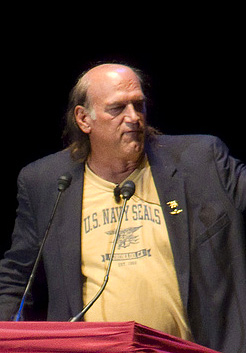
Jesse Ventura (photo by Cory Barnes, used under CC BY-SA 2.0)
On Monday afternoon, April 11, I appeared on Southern California Public Radio KPCC’s Patt Morrison show to briefly debate (dare I saw wrestle?) the former Navy Seal, Minnesota Governor, professional wrestler, television host, and author Jesse “The Body” Ventura, who was on a book tour swing through Los Angeles promoting his latest conspiracy fictions he believes are facts entitled The 63 Documents the Government Doesn’t Want You To Read. (The figure of 63 was chosen, Jesse says, because that was the year JFK was assassinated.) Presented in breathtaking revelatory tones that within lies the equivalent of the Pentagon Papers, what the reader actually finds between the covers are documents obtained through standard Freedom of Information Act requests that can also be easily downloaded from the Internet.
No matter, with bigger-than-life Jesse Ventura at the conspiratorial helm everything is larger than it seems, especially when his unmistakable booming voice pronounces them as truths. I had only a few hours to read the book, but that turned out to be more than adequate since most of the documents are familiar to us conspiracy watchers and what little added commentary is provided to introduce them appears to be mostly written by Ventura’s co-author Dick Russell, the pen behind the mouth for many of Jesse’s books. (Since he is no longer wrestling perhaps he should change his moniker to Jesse “The Mouth” Ventura.)
Surprisingly, given his background in the military and government, Ventura seems surprised to learn that governments lie to their citizens. Shockingly true, yes, but just because politicians and their appointed cabinet assigns and their staffers sometimes lie (mostly in the interest of national security but occasionally to cover up their own incompetence and moral misdeeds), doesn’t mean that every pronouncement made in the name of a government action is a lie. After all, as in the old logical chestnut—“This statement is untrue” (if it’s true it’s untrue and vice versa)—if everything is a lie then nothing is a lie. Likewise, I noted up front on the show, if everything is a conspiracy then nothing is a conspiracy.
Given the helter skelter nature of talk radio and Jesse’s propensity to interrupt through his booming voice any dissenters from his POV, I tried to make just four points. Let’s call them Conspiracy Skeptical Principles.
Conspiracy Skeptical Principle #1: There must be some means of discriminating between true and false conspiracy theories. Lincoln was assassinated by a conspiracy; JFK was not. The Archduke Franz Ferdinand was assassinated by a conspiracy of Serbian operatives that triggered the outbreak of the First World War; Princess Diana was not murdered by the Royal Family or any other secretive organization, but instead died by the most common form of death on a highway: speeding, drunk driving, and no seat belt.
Conspiracy Skeptical Principle #2: Cognitive Dissonance and the need to balance the size of the event with the size of the cause. Jesse Ventura said: “Do you mean to tell me that 19 guys with box cutters taking orders from a guy in a cave in Afghanistan brought down the most powerful nation on earth?” First of all, America is alive and well, thank you, even though Ventura has since moved to Mexico. But, yes, as a matter of fact, that is the only way such an event can happen: Sizable cohorts of operatives in prominent positions (Bush, Rumsfeld, Chaney, the CIA, the FBI, et al.) are too noticeable to get away with such a conspiracy. (By the way, 9/11 was a conspiracy: 19 members of Al Qaeda plotting to fly planes into buildings without telling us ahead of time constitutes a conspiracy.) It is the lone nuts living in the nooks and crannies of a free society (think Lee Harvey Oswald, John Hinkley, etc.) who become invisible by blending into the background scenery.
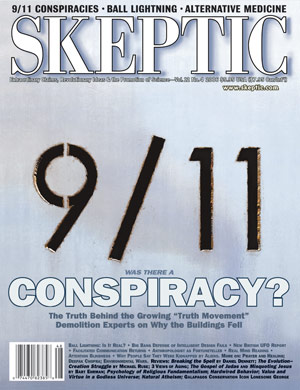
Order the Skeptic magazine 9/11 issue and read Phil Molé’s take on the “9/11 Truth Movement” on Skeptic.com
Conspiracy Skeptical Principle #3: What else would have to be true if your conspiracy theory is true? Jesse proclaimed on the show that the Pentagon was hit by a missile. His proof? He interviewed a woman on his conspiracy TV show who said she worked inside the Pentagon and never saw a plane hit it. Well, first of all, earlier in the show when I brought up Jesse’s conspiracy television series he discounted it, saying “that’s pure entertainment.” But now he wants to use an interview from that same show not as entertainment but as proof. As well, hardly anyone working in the Pentagon that day saw anything happen because they were inside the five-sided building and the plane only hit on one side, and even there, presumably (hopefully), people are actually working and not just sitting there staring out the window all day. But to the skeptical principle: As I said on the show, “If a missile hit the Pentagon, Jesse, that means that a plane did not hit it. What happened to the American Airlines plane?” Jesse’s answer: “I don’t know.” Sorry Jesse, not good enough. It’s not enough to poke holes at the government explanation for 9/11 (a form of negative evidence); you must also present positive evidence for your theory. In this case, tell us what happened to the plane that didn’t hit the Pentagon because there are a lot of grieving families who would like to know what happened to their loved ones (as would several radar operators who tracked the plane from hijacking to suddenly disappearing off the screen in the same place as the Pentagon is located). Finally, I directed Jesse and our listeners to www.skeptic.com to view the photograph of the American Airlines plane debris on the lawn in front of the Pentagon, below. Are we to believe that the U.S. government timed the impact of a missile on the Pentagon with the hijackers who flew the plane into the Pentagon?
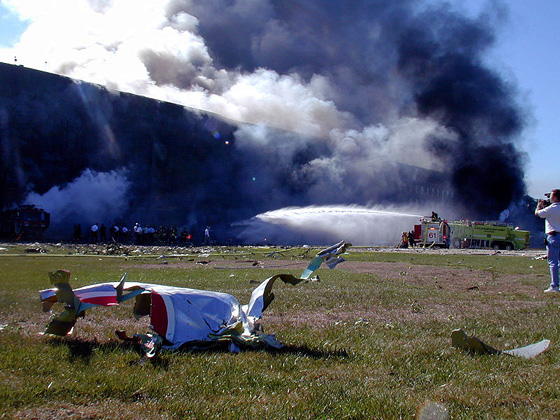
010911-N-6157F-001 Arlington, Va. (Sep. 11, 2001) — Wreckage from the hijacked American Airlines FLT 77 sits on the west lawn of the Pentagon minutes after terrorists crashed the aircraft into the southwest corner of the building. The Boeing 757 was bound for Los Angeles with 58 passengers and 6 crew. All aboard the aircraft were killed, along with 125 people in the Pentagon. (Photo by U.S. Navy Photo by Journalist 1st Class Mark D. Faram) (RELEASED)
Conspiracy Skeptical Principle #4: Your conspiracy theory must be more consistent than the accepted explanation. Jesse says that Osama bin Laden and Al Qaeda did not orchestrate 9/11, and instead it was done by the Bush administration (or, he says, at least by Chaney and his covert operatives). As evidence, Jesse wants to know why Osama bin Laden has not been indicted for murder by the United States government. As well, he says, why was no one fired for not acting on the famous memos of the summer of 2001 that warned our government that Al Qaeda was financing operatives in America in flight training schools and that Osama bin Laden would strike on U.S. soil. Hold on there Jesse—first you say that Osama bin Laden and Al Qaeda are innocent of this crime, and then you present evidence in the form of documents that the U.S. government was forewarned that Osama bin Laden and Al Qaeda would attack us? Sorry sir, you can’t have it both ways. You can’t hold to two contradictory conspiracy theories at the same time and use evidence from each to support the other. (Well, you can, but that would be a splendid example of logic-tight compartments in your head keeping separate contradictory ideas.)
Finally, in frustration I presume, Jesse accused me of being a mouthpiece of the government, just parroting whatever my overlords command me to say to keep the truth hidden. That conspiracy theory happens to be true, except for the part about the mouthpiece, the government, the parrot, and the truth.
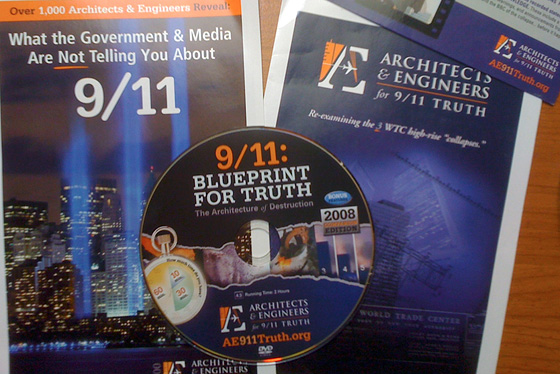
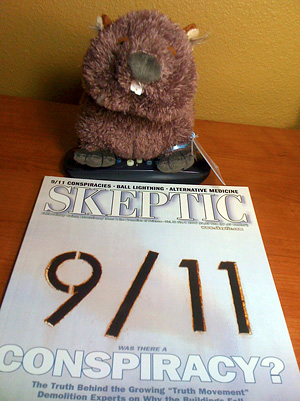
P.S. During my recent lecture tour swing through Wisconsin I was confronted at a restaurant by three 9/11 Truthers who were unable to attend my talk that night or even join the local skeptics group meeting that afternoon with me, and instead handed me a pile of literature and a DVD to watch touting the merits of the group known as Architects and Engineers for 9/11 Truth, who appear to hold fast to the belief that the WTC buildings were intentionally demolished by explosive devices AND that the hijackers (whoever they really were) somehow managed to fly the planes into the WTC buildings at precisely where the demolition experts planted the explosive devices—at the exact correct floors, at the exact angle at which the wings were tilted, because that is where the collapse of both buildings began. Check it out yourself below, along with our issue of Skeptic on 9/11 conspiracy theories, which was being read in Wisconsin by the little Wombat given to me by my hosts at the University of Wisconsin.
Copyright 2023 Michael Shermer | All Rights Reserved | 3938 State Street, Suite 101, Santa Barbara, CA, 93105-3114 | 1-805-576-9396